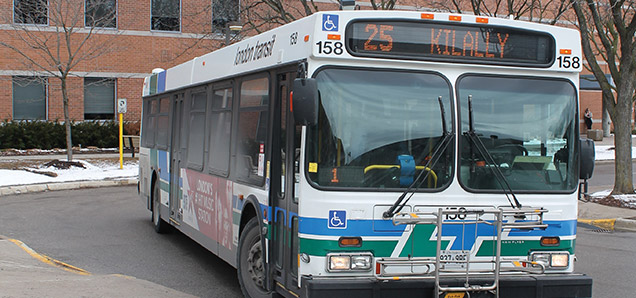London SHIFTs into high gear
 CREDIT: STEPHANIE LAI
CREDIT: STEPHANIE LAILondon transit continues to be of students' concern, and city staff held a presentation on a new initiative called SHIFT.
Students were invited to help shape the Forest City’s transit future on March 25. With London’s population set to grow by 77,000 over the next 20 years and students currently accounting for up to 40 per cent of LTC’s ridership at peak times, staffers from the city and Fanshawe Sustainability Services organized an interactive Q&A session about the future implementation of a rapid transit system.
The event was held on campus in room D1060.
“The challenges of this city are unique, a city of rivers and rail lines,” London director of Roads and Transportation Edward Soldo mentioned, saying that due to this major pinch points have grown out of the city’s current congestion issues.
The plan – called SHIFT – is London’s rapid transit initiative, born from the recently created London Plan. It will deal with problems of street congestion, overcrowding on buses and looking at new ways to move Londoners, making sound infrastructure investments to London’s roads and traffic before it becomes a larger, more expensive problem. The first step to SHIFT is an environmental assessment, which will determine what, where and how transit infrastructure will be built.
Soldo pitched the rapid transit discussion a different way towards the end, explaining that something will need to be done no matter what. Rough estimates of road widening run over $300 million, which would be paid out of Londoners pockets fully. With rapid transit, although the estimates for this program start at $380 million, up to two thirds of this can be paid for with help from the provincial and federal governments.
What city staff stressed is that this is an investment in our community. “Mobility and accessibility equal prosperity,” Soldo said. He says another goal of SHIFT is to build London into a city ready for new businesses to start and grow.
While the SHIFT relies on the LTC, it was disappointing to see not a single member from the transit commission. Though it was mentioned they were unavailable due to a monthly budget meeting, however, it didn’t make LTC look any better in students’ eyes.
Students kept city staff on their toes throughout the event, pointing out the new rapid transit lines ends at Oxford and Highbury, blocks short of Fanshawe College, despite students and staff being an integral part of LTC’s ridership. Staff stressed that that was not the end of the line, and that the focus on Oxford and Highbury was to possibly make it a transit park similar to what is at Masonville Place, a dedicated area for busses to stop with multiple enclosures for riders to wait.
Students also mentioned the lack of transit after midnight as a serious problem the city needs to fix. The issue is seen as a safety risk for those who want or need to stay late for studying, and a problem for others when their after-school jobs go into the morning hours, not an uncommon thing in London.
City staff were receptive and willing to answer any questions, staying after the presentation to talk with students who want to voice other issues or just to clarify points of the Q&A period. They also encouraged students to continue their input into SHIFT using the hashtag #ldnshift and to find more info at information at shiftlondon.ca













